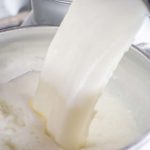Although booster shots are extending protection from Covid, Doherty Institute director Professor Sharon Lewin said the world needed better vaccines offering longer immunity, protection against new variants and which are cheaper to make.“We have got great vaccines, but they were sort of first generation vaccines and there’s a lot of room still for improvement,” Prof Lewin said.“The most concerning thing with the current vaccines is the waning immunity. We still don’t know whether there’s going to be significant waning after the third dose.”Monash’s Professor Colin Pouton said it is vital to have improved vaccine platforms that can be adapted to suit Covid’s evolution.“It’s still not really clear whether we will need an Omicron vaccine globally. It’s not clear whether we’ll need vaccines for variants that haven’t yet emerged. It’s not clear whether we’ll need protection on a yearly basis,” Prof Pouton said.“So they’re still planning on a monthly basis where to go.”Will the Melbourne vaccines be better than those already available?Because the Melbourne vaccine candidates are more focused in the way they attack the Covid-causing SARS-CoV-2 virus, their creators hope they will produce a stronger and moreconcentrated defence against it.Rather than targeting harmless parts of the virus, current vaccines prime the immune system to focus its attack only on the spike proteins on its surface, blocking their ability to infect other cells.But the Melbourne vaccines refocus this attack at a whole new level. Ignoring even the bulk of the spike protein, the new generation vaccines focus entirely on the receptor-binding domain — an area at the tip of the spike accounting for just 10-15 per cent of its surface, but which is solely responsible for attaching to and infecting other cells.Samples from people infected with Covid show 90 per cent of the neutralising antibodies produced to fight off the virus are focused on the RBD.If the spike protein is the virus’ arms, the Doherty’s Professor Dale Godfrey explains that the RBD is its hand — and focusing 100 per cent of the attack at that most crucial area should penhance our defence.“We’ve now narrowed it down to not the arm, but just the hand at the end of the arm the virus uses to grab a hold of the cells in ur airways,” Prof Godfrey said.“Our theory is that if you only expose that part of the virus to the immune system, then you’ll get a more concentrated response directed against that critical part of the virus.”And while first-generation vaccines are based on Covid’s original Wuhan strain, both Melbourne vaccines base their genetic make-up on its Beta strain.This may create a crucial difference.Because the dominant Omicron variant has several key genetic mutations that were not present in the Wuhan strain, the effectiveness of the first generation vaccines against it is limited.However, two of the three key mutations in Omicron were also present in Beta, meaning the new Melbourne vaccines may be better suited to take on the biggest real-world dangers.“The key question — will our vaccine give a better response against Omicron because it has at least two of the mutations that are shared with Omicron?” Professor Godfrey said.“We don’t know. We hope so.”What are differences between the two Melbourne vaccines?Vaccines work by presenting a harmless part of a virus to our immune system, so it can learn which antibodies it needs to produce in order to fight the virus off.But the way each of the Melbourne jabs does this is vastly different.The Doherty Institute’s recombinant protein vaccine candidate contains part of the RBD protein to directly show the immune system what it is up against and elicit a response.Monash’s mRNA vaccine candidate is more complicated.Rather than include part of the actual protein, scientists instead used the genetic sequence of the RBD and included its in the vaccine.Pros and cons of the Doherty protein vaccineProtein vaccines are generally more stable than their mRNA counterparts and do not need to be frozen, making them easier to transport and administer around the world.The Doherty has found its RBD vaccine candidate remains perfectly usable after six months atrefrigerator temperatures and is conducting tests to see how long it can be stored at temperatures up to 37 degrees.The protein vaccine should also be cheaper to manufacture, transport and store.The first generation of Covid jabs have also shown the protein versions have been better tolerated than their mRNA counterparts, with lower rates of short-term side effects, including discomfort and arm soreness.Pros and cons of the Monash mRNA vaccineMessenger RNA — or mRNA — vaccines do not contain any part of a virus.Once developed, they can also be quickly adapted to suit a new variant or mutation by replacing the genetic code of the old variant with the newly sequenced variant — like changing the payload on a missile.“And it’s very easy to produce that payload, as well,” Professor Pouton said. “To go from one version to another with mRNA, they’re doing it now from start to finish in 100 days, all the way through efficacy studies. “To actually make the new vaccine is, like, two days’ work.”But mRNA vaccines need to be kept at -80 degrees.Why have the Melbourne vaccines taken longer to develop than those overseas?There are billions of reasons Australia’s vaccines have taken longer to produce — billions of dollars, that is.In April 2020 the Melbourne labs were only a week or two behind international teams at Moderna and BioNTech (Pfizer) in the development of their vaccine candidates.But then funding gaps between university-backed and commercially backed labs became apparent, as did the lopsided scale of economy in Australia and overseas.“When Covid came along, the European and the US governments just threw huge amounts of money at the opportunity and it worked out,” Professor Pouton said.“At that point they got an injection of funding. Moderna had $1bn from the US government.“Obviously it’s a little frustrating because you think, ‘well, Australia could do this’. But at the same time we’re not an economy the size of the US and can’t find $1bn to have an each-way bet on a few vaccines, that’s the problem.“In Australia we’ve just gradually got along getting government funding and grant funding as we’ve gone.”In any normal situation genetically sequencing a new virus, developing a vaccine and preparing for a Phase 1 trial within two years — as the Melbourne labs have done — would be astounding.But while Melbourne’s scientists are the equal of any in the world, Professor Lewin said Australia’s funding process lagged a long way behind, particularly when asked to accelerate amid the urgency of a pandemic.“I wish we could have moved quicker, because we have been limited,” she said.“I think it’s fantastic that the teams have come together to work so collaboratively, got support from both the MRFF as well as mRNA Victoria and other funders. But ideally, we would have loved to be able to move quicker on this as other parts of the world have.“And that’s not a problem with our researchers, that’s a problem with how we fund research.”A lack of manufacturing in Australia also complicated development.For the brand-new mRNA technology it was particularly difficult, forcing the Monash team to adopt a longer three-stage process, where they first produced the DNA that could be used as the template for the RNA formulation needed to be produced as the injectable vaccine product.The DNA was then sent to a Belgium clean room, which scaled-up production to produce enough mRNA for the clinical trial. That solution was then frozen and sent back to Melbourne, where local manufacturer IDT Australia turned it into Monash’s completed vaccine.While the delays may have frustrated Melbourne’s scientists, they have brought some silver linings.Whereas the first Covid vaccines needed massive 40,000-person trials costing $500m each, many of their earliest lessons do not need to be repeated, paving the way for smaller and cheaper trials.And it may also mean that the new improved Melbourne vaccines are ready when they are most needed to coincide with new variants — provided they pass those trials.Who will be the first to get a Melbourne jab?The first of 114 adults will receive a shot over the next few weeks at the Royal Melbourne Hospital, with the remaining 18-70-year-olds to follow over the next three months.However, exactly what and how much they are dosed with will be unknown by the volunteers.One in five of the double-blind trial participants will receive a placebo to act as a control group, while the others will be split evenly to receive the Doherty protein vaccine or a Monash mRNA dose.Those receiving the active vaccine candidates will be divided into three further groups — to receive a lower, medium or higher dose — to determine the optimal dose.All of those taking part in the human trial must have already had their third dose of a Covid vaccine. They can also enter the trial if they have been infected with COVID-19, but this has to have been at least three months earlier, and they must have received their third vaccine dose as well.AllThey will also have to revisit the trial clinic about eight times to have blood and other samples taken, as well as keeping a diary of any side effects or reactions. The trial was originally planned to begin in January to test the effectiveness of the vaccine candidates as a third dose booster. However, plans radically changed when the Omicron wave hit and Australia’s third-dose strategy was adopted — meaning many of the likely recipients would have already been jabbed. How will they know if they work?There are three aims of the Phase 1 human trial.First and foremost, the clinical trial specialists from the Doherty Institute and RMH’s Infectious Disease Service will monitor participants to ensure the vaccines are safe and do not produce serious side effects.Next, the scientists will look for early indications that the jabs work. But, because Australia already has high vaccination coverage, it is not as simple as seeing who catches Covid and who does not.Instead, the researchers will undertake blood tests to measure the jabs’ immunogenicity – their ability to produce an effective immune response — to see if they prompt neutralising antibodies able to overcome Covid as well, or better, than currently approved vaccines.Finally, clinical trial leader Professor Terry Nolan, and colleagues will compare results from the three different dose levels to see which performed the best.“Phase 1 is principally about safety and broadly about ‘are these vaccine candidates going to work’, ‘can we get a rough idea of what the right dose is before we proceed to a bigger study’,” Professor Nolan said.There will also be another significant bonus of the Melbourne study — it will be the first time anyone in the world has examined two different Covid vaccines at the same time, allowing an unprecedented examination of how the protein and mRNA platforms stack up.“We’ll be able to see the differences in the antibody responses between the protein and the mRNA recipients, and at the different dose levels we’ll be able to look at the reaction rates in both and see what they’re like too,” Professor Nolan said.“The human study, all the lab results and the essays on the antibodies that we’ll be measuring, will be done in the same lab. So it’s perfectly comparable and we don’t have issues of having different standards in different labs, which is always an issue.”What’s the next step?If the Phase 1 trial is successful for one or both of the vaccines, they will progress to a larger Phase 2 trial to gain a more precise indication of their effectiveness.A bigger step would be a large Phase 3 trial involving thousands of volunteers. International regulators including Australia’s TGA and the US’s FDA are also working to develop threshold levels of antibodies that can be measured, which may be ready to reduce the size of a Phase 3 trial and fast-track approval of the next-generation vaccines.But the biggest step is likely to occur outside any lab or trial vaccination site — attracting corporate backers to push the vaccine candidates through the expensive trial process.“If our vaccine performs well in our Phase 1 — and we should start to get an idea within a few months — our hope is that we will get a lot more support from industry to pick it up and develop it through the next Phase 2 and Phase 3 stages,” Professor Godfrey said.“If all goes well, we should also then be in a position to be moving a lot faster and have a vaccine that is approved and ready for release. “There’s a lot of ifs in the middle between now and then, but that’s our hope.”
Powered by WPeMatico






